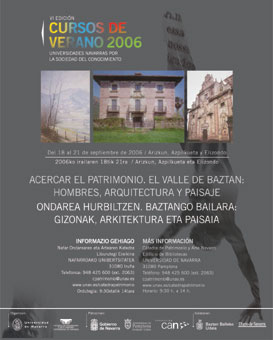BRINGING HERITAGE CLOSER. THE BAZTAN VALLEY: MEN, ARCHITECTURE AND LANDSCAPE
21 September 2006
Indian art and architecture in the Baztan Valley. The 19th and 20th centuries
Dr. Javier Azanza López. Chair of Navarrese Art and Heritage.
The phenomenon of migration to America in the last third of the 19th century and the first third of the 20th century was intense in Navarre, although with differentiating nuances, it followed the general patterns of other regions such as Galicia, Asturias, Cantabria and the Basque Country. The northern valleys of Basaburúa, Ulzama, Aezkoa and Larráun, but above all the Atlantic Navarre concentrated in Baztán, Bertizarana and Cinco Villas, were the main departure points for numerous emigrants from Navarre during this period.
The profile of the emigrant from Baztan is that of a single man, aged between 20 and 25, a farmer and with little money programs of study, who went to America with the aim of "improving his fortune" goal . The departure platforms were mainly the ports of Pasajes and Bayonne, and to a lesser extent those of Bordeaux and San Sebastián. In terms of destinations, Argentina and Uruguay stand out above the rest, clearly distancing themselves from other options such as Mexico, Cuba or the Philippines.
The result of remembrance or of the return of the Americans to the Baztan is a rich urban and monumental bequest which becomes the best testimony to the prosperity achieved. The financing of religious architecture in parishes such as those of Errazu, Oronoz and Elizondo; the construction of stately homes and residences, either maintaining the local building tradition or in buildings of marked singularity as a testimony to the eclecticism of the period; the promotion or improvement of school buildings, among which the schools of San Martín and Nuestra Señora del Carmen in Oronoz stand out; the construction of facilities such as pelota courts and cemeteries; or public works and infrastructure, mainly focused on the network road, water supply and street lighting; all of them are examples of how American capital returned to the Valley and contributed to keeping the memory of its Indianos alive among the people.

PROGRAM
MONDAY, 18 SEPTEMBER
Place: Elizondo. Arizkunenea Cultural Centre
16.45 h: Opening and presentation of the course
17 h. Juan de Goyeneche, ahead of his time
Prof. Dr. Alfredo Floristán Imízcoz. University of Alcalá de Henares
18 h. Coffee break
18.30 h. Ziga, Lekaroz and Gartzain: the churches of the Renaissance in the Baztan area
Prof. Dr. María Josefa Tarifa Castilla. Chair of Navarrese Heritage and Art
TUESDAY, 19 SEPTEMBER
Place: Elizondo. Arizkunenea Cultural Centre
17 h. From the village to the Court
Prof. Dr. José María Imízcoz Beunza. University of the Basque Country
18 h. Coffee break
18.30 h. Palaces of Baztan
Prof. Dr. Pilar Andueza Unanua. Chair of Navarrese Heritage and Art
Then visit to the Ethnographic Museum of Baztan Jorge Oteiza, guided by Ms. Ana María Marín, member of the Friends of the Museum.
WEDNESDAY, 20TH SEPTEMBER
Place: Arizkun. Convent of the Poor Clares
17 h. Juan Bautista Iturralde and his foundations
Prof. Dr. María Concepción García Gainza. Chair of Navarrese Heritage and Art
Place: Azpilkueta. Parish
18.30h. Families and artistic promotion: Elizacoechea in Azpilkueta, the Jáuregui family in Oharriz
Prof. Dr. Ricardo Fernández Gracia. Chair of Navarrese Heritage and Art
THURSDAY, 21ST SEPTEMBER
Place: Elizondo. Arizkunenea Cultural Centre
17 h. Indian art and architecture in the Baztan Valley. The 19th and 20th centuries
Prof. Dr. Javier Azanza López. Chair of Navarrese Heritage and Art
18 h. Coffee break
18.30 h. Closing session: The Bidasoa School and landscape painting in Baztania.
Prof. Dr. Francisco Javier Zubiaur Carreño. Museum of Navarre
